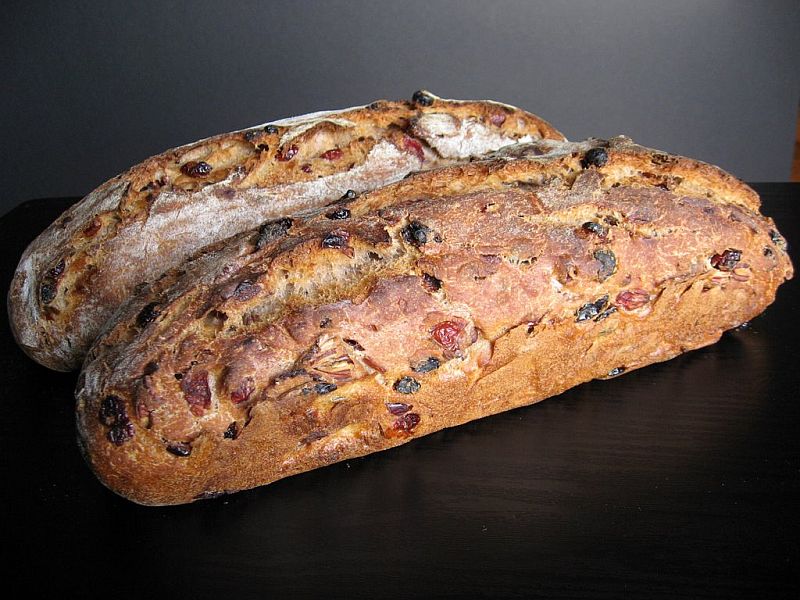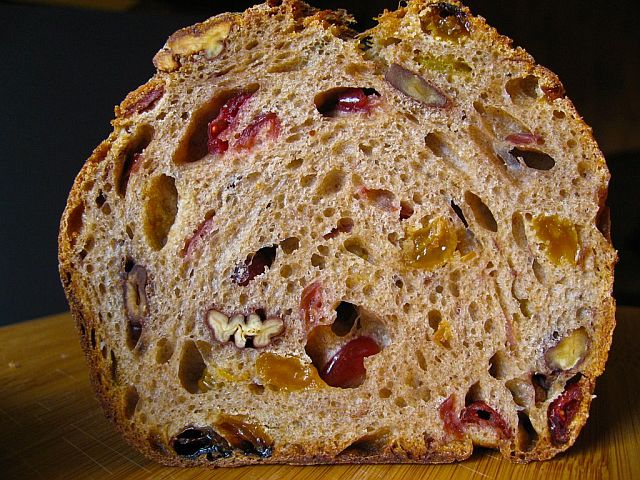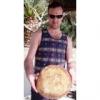I finally invested in a new baking stone, one that fills an oven shelf with only a couple of inches to spare. Now I can make baguettes that approach 18" to 20" in place of the stubby ones I baked before. Consequently, along with sourdough, sticky buns, foccacia, and getting familiar with spelt, I've been baking my own baguette formula that has borrowed heavily from Anis Bouabsa's formula and especially his process, and, in the most recent batch, Peter Reinhart's pain a' l'ancienne procedures. I've made this formula three times, tweaking a little each time, not the ingredients, the procedures. I've nicknamed them "Overnight Baguettes.
Formula for 1000 g finished dough
All purpose flour 575g 100%
Water 414g 72%
Salt 12g 2%
Instant Yeast 1/4 tsp. ???
I mix all the dry ingredients together in a wide bowl, and add the water. Using a plastic dough scraper I incorporate the water into the dry mix, cover and rest it for one-half hour.I turn the dough out onto a very lightly dusted board and French fold until dough passes the window pane test. Chill (details follow: I tweaked here.). Remove from chiller. Bring to room temperature (details follow: tweak #2). Preshape, rest, shape, and final proof. Preheat oven to 500°F. Pre-steam oven. Load slashed loaves reduce temperature to 450°F immediately. After ten minutes remove steam source (if you can do it safely), vent oven and finish baking.
I did all my mixing with ingredients at room temperature (low seventies-ish) for the first two batches. For the first batch, ala Bouabsa, I left the dough in the refrigerator 21 hours @ 38°F. For the second batch I placed it in our wine closet @ 55°F for seventeen hours. For both batches I did two stretch-and-folds after the first 50 and 100 minutes. These two S&F's leave the dough very elastic and smooth (I think it feels "silky").
In both cases, after I turned out the chilled dough (again, following Bouabsa) I immediately divided the dough into three equal amounts, preshaped, and let the dough rest for one hour.
The first batch's dough increased about one-and-a-half its original volume in the refrigerator. Despite dividing and resting the dough was still chilled when I final-shaped it, and final proofing took two hours and fifeteen minutes.
The second batch's volume tripled in the wine closet (I worried about losing any chance of oven-spring). The dough was particulary puffy after resting an hour (more oven-spring worry). Final proofing took 90 mins. My worries were dispelled in the first ten minutes in the oven. Both batches exhibited good oven-spring, but the flavor of batch #1 was distinctly more bland then batch #2. The crumb of both batches was open, light, and slighty chewy.
I was generally happy with both batches, but the second batch's flavor won out. Whatever flavoring chemistry goes on in retarded dough appeared to work harder at the wine closet's elevated temperature.
Despite the oven-spring experienced in batch #2, I was still worried I was setting myself up for future failures letting the dough triple in volume during its retarded proof at 55°F. I recently broke down and bought Peter Reinhart's "The Bread Baker's Apprentice". His anecdote about capturing the hearts and minds of his more reluctant students when they are first introduced to pain a' l'acienne dough pushed me to skip to its formula. I was intrigued by his "shock retardation" using ice water to mix the dough.
I mixed the third batch's dough with ice water, and also placed it in the wine closet during its autolyse rest. I checked the dough a couple of times after performing the two S&F, and was a little worried by almost no apparent action. Encouraged by the few little bubbles I could see through the bottom of the plastic container I went to bed, but set the alarm to remove the dough after fifeteen hours chilling. The dough was just short of doubled when removed. Following Reinhart's directions I let the dough sit, undivided at room temperature (high sixties-ish) for two hours. When I got out of bed the second time the dough was well doubled and the top of the dough was stretched in a couple of places by large gas bubbles. I liked what I saw, and felt.
I divided the dough, preshaped, and let it rest twenty minutes. Following, I shaped, and final-proofed for ninety minutes (I use a poke test to decide proofing status, but I keep track of time too.) Baking proceeded as described above.
The results:

We are delighted with the flavor, and crumb! This is going to be our "go to" baguettes: no more tweaking.
David G






































